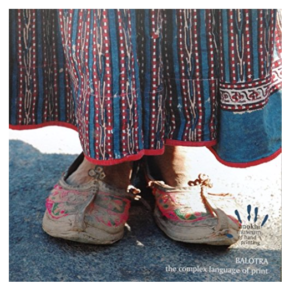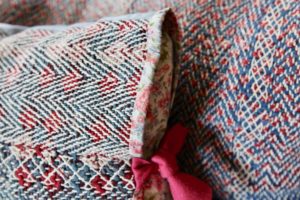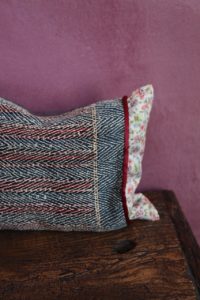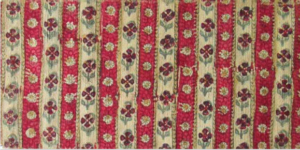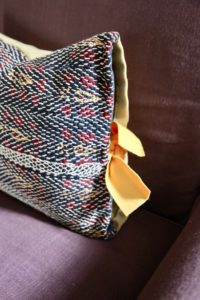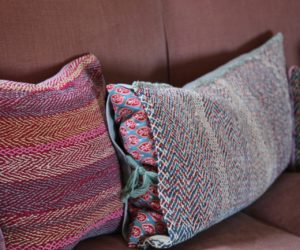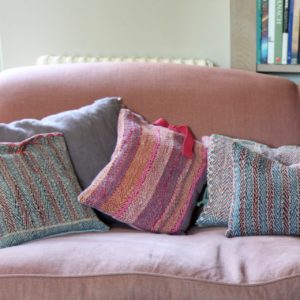Balotra in the Barmer region of Rajasthan, India is approx 90 kilometres from Jodphur. This area too has a long history of hand block printing, using the typical local and vegetal dyes to yield blue, red, yellow, black and white in varying combinations and tones.
Image from Calluna: Cushions – Heather Luke
As with all generational hand crafted skills, the market has been hit by the industrialisation and price competitive marketing so intent on reaching the ends of the earth for self indulgent economic gain. Today just a few families of dyers and printers remain, the craftsmanship supported by a growing awareness of the fragility of such places. The fashion for everyday western styles clothes and certainly for business wear has also reduced the need for distinctive community cloths to a degree. Although there are many who change to their own traditional clothing at home.
Image from Calluna: Cushions – Heather Luke
For at least the last 10- 11 centuries the typical Balotra women’s garments comprises a very full skirt, the ghaggra with a bodice over, known as choli, and a head wrap, an odhani. These are clothes that allow easy movement for the many tasks a country woman was required to do, from looking after home and children, to working the land; the fine soft cotton would be cooling in the sun and warming at night. Blankets and scarves, add warmth and dress the basic outfit ‘up and ‘down’. for occasion and function. Silver jewellery by quality and quantity showed the wealth of the family, necklaces, arm and leg bangles.
Wood block print cotton circa 1800 from Balotra, Rajasthan.
In all traditional cultures the family, the village, age and marital status are told by the stories contained in the pattern, the colours and the embroideries.
For the Balotra, a married women shows her status by the yellow piped, red border stitched to the hem of the skirt. Once widowed, the border is removed. Pattern shows the age, the immediate idea of which I guess would horrify most of us. And yet, don’t most us us also choose less obvious and colourful designs as we mature ….. gracefully ?
The cloth type also. The less well off have limited access to high quality, by economic and class differentials, so their materials are more rustic, uneven, coarse. And don’t we all, wherever we live, in any meritocratic system choose better cloth, more sophisticated designs etc. the wealthier we become ?
Image from Calluna: Cushions – Heather Luke
We have used the small pieces of stitched Balotra fabrics bought in Rajasthan for cushions. These are the remnants and offcuts which have been quilted with a technique that uses coarse cotton stitching to rivulets of small pleats, to make the fabric thicker and more robust. Really interesting work. We’ve used them with other locally hand blocked textiles, with Liberty prints, plain linens, Scottish tweed, chintz and wool melton hessian, ticking and gingham – to name a few. One of the things we love most about these pieces is their versatility and ability to mingle with all other materials.
Here are some others:
Image from Calluna: Cushions – Heather Luke
BALOTRA-Complex-Language-Print-Ronald/dp/8190392212
https-//hali.com/news/dont-miss-india-an-exhibition-of-photographs-of-india-and-textiles-from-the-subcontinent/
https://en.wikipedia.org/wiki/Balotrahttps://www.amazon.co.uk/

